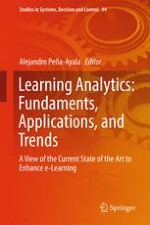2017 | OriginalPaper | Chapter
3. A Landscape of Learning Analytics: An Exercise to Highlight the Nature of an Emergent Field
Authors : Alejandro Peña-Ayala, Leonor Adriana Cárdenas-Robledo, Humberto Sossa
Published in: Learning Analytics: Fundaments, Applications, and Trends
Publisher: Springer International Publishing
Activate our intelligent search to find suitable subject content or patents.
Select sections of text to find matching patents with Artificial Intelligence. powered by
Select sections of text to find additional relevant content using AI-assisted search. powered by
